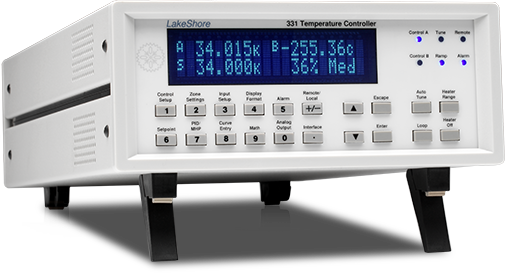Connecting to Model 331 by Lakeshore in Python
Instrument Card
The Model 331 cryogenic temperature controller combines the easy operation and unsurpassed reliability of the Model 330 with improved sensor input and interface flexibility, including compatibility with negative temperature coefficient (NTC) resistance temperature detectors (RTDs). Backed by the Lake Shore tradition of excellence in cryogenic sensors and instrumentation, the Model 331 temperature controller sets the standard for mid-price range temperature control instruments.

Device Specification: here
Manufacturer card: LAKESHORE

Supporting advanced scientific research, Lake Shore is a leading global innovator in measurement and control solutions.
- Headquarters: Westerville, Ohio, USA
- Yearly Revenue (millions, USD): 21.4
- Vendor Website: here
Connect to the Model 331 in Python
Read our guide for turning Python scripts into Flojoy nodes.
PROTOCOLS > SCPI
To connect to a Model 331 Temperature Controller using Qcodes Community, you can use the following Python script:
from qcodes import Stationfrom qcodes.instrument_drivers.Lakeshore.Model_331 import Model_331
# Create a station to hold the instrumentsstation = Station()
# Connect to the Model 331 Temperature Controllermodel_331 = Model_331('model_331', 'GPIB0::1::INSTR')station.add_component(model_331)
# Print the heater outputprint(model_331.heater_output())
# Set the heater range to 5Wmodel_331.heater_range('5W')
# Print the temperature of channel Aprint(model_331.channels.ChanA.temperature())
# Set the setpoint temperature to 300 Kmodel_331.setpoint(300)
# Print the setpoint temperatureprint(model_331.setpoint())
# Disconnect from the instrumentsstation.close_all_registered_instruments()This script creates a Station object to hold the instruments. It then connects to the Model 331 Temperature Controller using the Model_331 class from the qcodes.instrument_drivers.Lakeshore module. The instrument is added to the station using the add_component method.
The script then demonstrates some basic operations with the instrument. It prints the heater output using the heater_output parameter, sets the heater range to 5W using the heater_range parameter, prints the temperature of channel A using the temperature parameter of the SensorChannel class, sets the setpoint temperature to 300 K using the setpoint parameter, and finally prints the setpoint temperature.
Note that you may need to adjust the GPIB address ('GPIB0::1::INSTR') to match the actual address of your instrument.